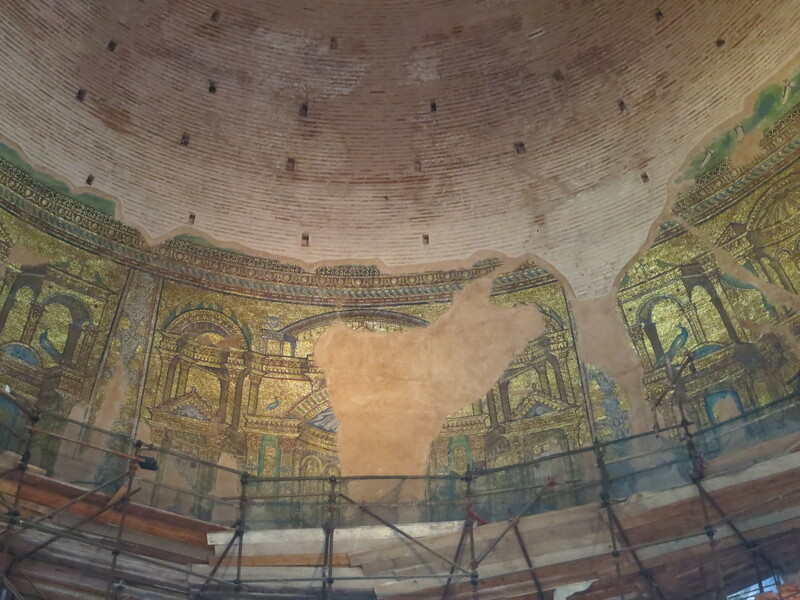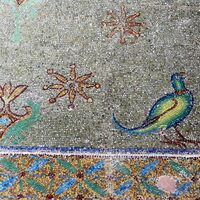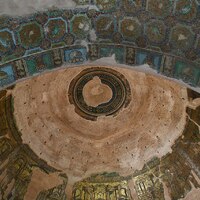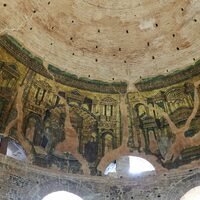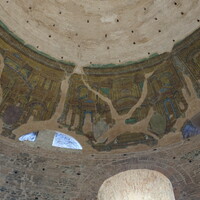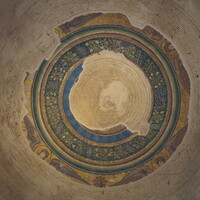Rotunda in Thessaloniki
Type:
Churches,
Mausoleums,
Monuments,
Mosaics,
Palace complexes
Date:
Late fourth to early sixth century; apse ninth century
Location or Findspot (Modern-Day Country):
Greece
Description:
This rotunda was built of rubble masonry and brick by the Roman tetrarch Galerius (r. 282–311). It was one of a group of structures Galerius erected around 300 in his capital, Thessaloniki, including a triumphal arch that narrates his victory over the Sasanian Empire. The rotunda may have been planned as a temple, like the Pantheon in Rome, or as a mausoleum, but Galerius was buried elsewhere. It became a Christian church at the end of the fourth century, with the closing of its oculus and the addition of an ambulatory and an eastern apse. Sometime between then and the early sixth century, the interior was decorated with marble revetment on the walls and exceptional mosaics in the dome and in the soffits of the barrel-vaulted recesses that punctuate the walls, which are 2 meters thick.
The soffits display mosaic grids that enclose birds, fruit, stars, or flowers. The dome had three registers of mosaic. At its base, the only well-preserved zone, male martyr saints (originally twenty of them) stand before an elaborate architectural backdrop. These two-story structures studded with precious gems shelter lamps, crosses, and Gospel books. The saints are accompanied by Greek inscriptions that indicate their name, occupation, and the month in which they were celebrated. For example, one is "Damianos, physician, September," and another "Philippos, bishop, October." In the next highest zone were apostles or angels; only their feet are preserved. Finally, the apex of the dome—30 meters above floor level—showed Christ in glory; a charcoal sinopia is preserved. He is surrounded by a wreath that separates him from angels and a nimbed phoenix, a symbol of immortality. The dome mosaics thus represent heaven as a celestial city to which these earthly martyrs have been elevated as incorporeal saints.
The apse was painted in the ninth century with the scene of Christ's ascension, when the rotunda was dedicated to the Archangels; it was later rededicated as the Church of St. George.
The soffits display mosaic grids that enclose birds, fruit, stars, or flowers. The dome had three registers of mosaic. At its base, the only well-preserved zone, male martyr saints (originally twenty of them) stand before an elaborate architectural backdrop. These two-story structures studded with precious gems shelter lamps, crosses, and Gospel books. The saints are accompanied by Greek inscriptions that indicate their name, occupation, and the month in which they were celebrated. For example, one is "Damianos, physician, September," and another "Philippos, bishop, October." In the next highest zone were apostles or angels; only their feet are preserved. Finally, the apex of the dome—30 meters above floor level—showed Christ in glory; a charcoal sinopia is preserved. He is surrounded by a wreath that separates him from angels and a nimbed phoenix, a symbol of immortality. The dome mosaics thus represent heaven as a celestial city to which these earthly martyrs have been elevated as incorporeal saints.
The apse was painted in the ninth century with the scene of Christ's ascension, when the rotunda was dedicated to the Archangels; it was later rededicated as the Church of St. George.
Relevant Textbook Chapter(s):
2
Image Credits:
Brad Hostetler, Flickr; Helen Miles; Wikimedia Commons
